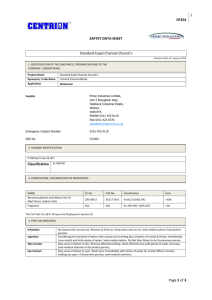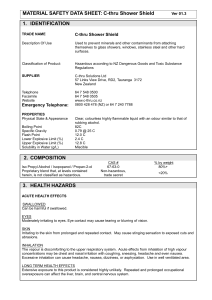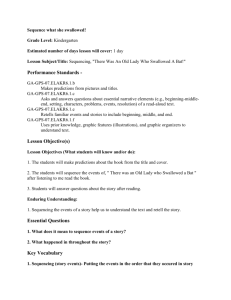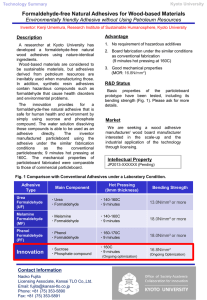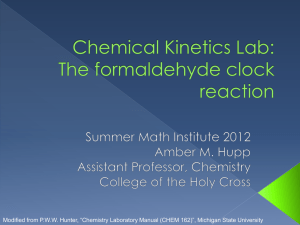SLS COSHH histology
advertisement
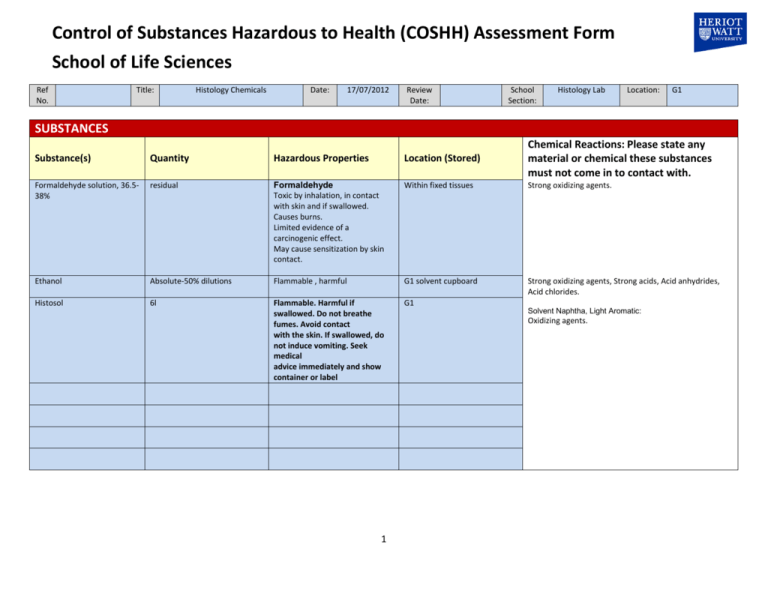
Control of Substances Hazardous to Health (COSHH) Assessment Form School of Life Sciences Ref No. Title: Histology Chemicals Date: 17/07/2012 Review Date: School Section: Histology Lab Location: G1 SUBSTANCES Substance(s) Quantity Hazardous Properties Location (Stored) Chemical Reactions: Please state any material or chemical these substances must not come in to contact with. Formaldehyde solution, 36.538% residual Formaldehyde Toxic by inhalation, in contact with skin and if swallowed. Causes burns. Limited evidence of a carcinogenic effect. May cause sensitization by skin contact. Within fixed tissues Strong oxidizing agents. Ethanol Absolute-50% dilutions Flammable , harmful G1 solvent cupboard Strong oxidizing agents, Strong acids, Acid anhydrides, Acid chlorides. Histosol 6l Flammable. Harmful if swallowed. Do not breathe fumes. Avoid contact with the skin. If swallowed, do not induce vomiting. Seek medical advice immediately and show container or label G1 1 Solvent Naphtha, Light Aromatic: Oxidizing agents. HEALTH EFFECTS / PREVENTATIVE & CONTROL MEASURES Hazard Existing Controls Additional Controls Formaldehyde: Tissue samples washed prior to being brought into lab. PPE – lab coat, eye protection and gloves Good Laboratory Practice Use personal protective equipment as required Use in a fume hood. Ensure no sources of ignition are nearby. Use personal protective equipment as required. Dispose of contents/containers to an approved waste disposal plant. Use personal protective equipment as required. Not expected to wear personal respirator during normal work. Dispose of contents/containers to an approved waste disposal plant. Wear personal respirator if vapour concentration becomes high. H314 - Causes severe skin burns and eye damage H317 - May cause an allergic skin reaction H370 - Causes damage to organs H311 - Toxic in contact with skin H331 - Toxic if inhaled H301 - Toxic if swallowed H351 - Suspected of causing cancer H226 - Flammable liquid and vapor Ethanol: H336 - May cause drowsiness or dizziness H319 - Causes serious eye irritation H225 - Highly flammable liquid and vapor EUH066 - Repeated exposure may cause skin dryness or cracking Histosol: H302 - Harmful if swallowed H304 - May be fatal if swallowed and enters airways. H340 - May cause genetic defects. H350 - May cause cancer. P233 - Keep container tightly closed. P301+P310 - IF SWALLOWED: Immediately call a POISON CENTRE or doctor/physician . P331 - Do NOT induce vomiting. Histo-Clear: DANGER H226 - Flammable liquid and vapor. H304 - May be fatal if swallowed and enters airways. H315 - Causes skin irritation. H317 - May cause an allergic skin reaction. H410 - Very toxic to aquatic life with long lasting effects. P273 - Avoid release to the environment. 2 Signature / Date Health Effects Level of exposure Type of exposure Duration of exposure Amount of substance to be used Amount of disposal How will it be disposed of P280 - Wear protective gloves/protective clothing/eye protection/face protection. P301+P310 - IF SWALLOWED: Immediately call a POISON CENTER or doctor/physician . P331 - Do NOT induce vomiting. P302+P352 - IF ON SKIN: Wash with plenty of soap and water. P333+P313 - IF SKIN irritation or rash occurs: Get medical advice/attention. P501 - Dispose of contents/containers to an approved waste disposal plant. Histomount: e.g. Ventilation, suitable work equipment, PPE, respirator, etc Does user require health surveillance Yes No Has this health surveillance been organized through Occupational Health? Yes No MONITORING OF EXPOSURE Air sampling in the breathing zone – is it required and if so has it been carried out Potential for skin absorption – has skin been checked? Is it a biological agent? Yes No Yes No Yes No If yes, what is the classification? Note: If this applies, make reference to COSHH Reg 6 (69) and comply with the requirements stated in the Code of Practice If any substance(s) are extremely flammable, state Can a less dangerous / hazardous substance or process be used? Do any substances have workplace exposure limits? Yes No Yes No TWA (8 hrs) STEL (15 mins) 2ppm 50ppm 2ppm 50ppm If so, please give details below: Substance Formaldehyde Histosol 3 lowest flash point ADDITIONAL INFORMATION Personal Protective Equipment Type Specification Supplier Notes First Aid Action Contact Area Swallowed Contact with skin Contact with eyes Inhaled Action Required Formaldehyde: Do NOT induce vomiting. Never give anything by mouth to an unconscious person. Rinse mouth with water. Consult a physician. Histosol: Do not induce vomiting. If swallowed and the person is conscious, immediately give large amounts of water. Get medical attention. Histo-clear: Do not induce vomiting. If swallowed and the person is conscious, immediately give large amounts of water. Get medical attention. Formaldehyde: Wash off with soap and plenty of water. Take victim immediately to hospital. Consult a physician. Histosol: Immediately flush skin with plenty of soap and water for at least 15 minutes while removing contaminated clothing and shoes. Get medical attention. Wash clothing before reuse. Thoroughly clean shoes before reuse. Histo-clear: Immediately flush skin with plenty of soap and water for at least 15 minutes while removing contaminated clothing and shoes. Get medical attention. Wash clothing before reuse. Thoroughly clean shoes before reuse. Formaldehyde: Rinse thoroughly with plenty of water for at least 15 minutes and consult a physician. Histosol: Immediately flush eyes with plenty of water for at least fifteen minutes, lifting lower and upper eyelids occasionally. Get medical attention immediately. Histo-clear: Remove contact lenses at once. Immediately flush eyes with plenty of water for at least fifteen minutes, lifting lower and upper eyelids occasionally. Get medical attention immediately. Formaldehyde: Move person into fresh air. If not breathing, give artificial respiration, using pocket mask. Consult a physician. Histosol: Remove to fresh air. If not breathing, give artificial respiration. If breathing is difficult, give oxygen. Call a physician. Histo-clear: Remove to fresh air. If not breathing, give artificial respiration. If breathing is difficult, give oxygen. Call a physician. Spillage or Accidental Release Fire Precautions Specify how you would deal with spillage or accidental release Specify actions to be taken in the event of a fire involving these substances Suitable extinguishing media Formaldehyde - Contain spillage, and then collect with an electrically protected vacuum cleaner or by wet-brushing and place in container for disposal according to local regulations . Keep in suitable, closed containers for disposal. Histosol - Isolate hazard area and deny entry. Keep ignition sources out of area and shut off all ignition sources. Absorb spill with inert material (e.g. dry sand or earth) then place in a chemical waste container. Histo-clear - Eliminate source of ignition. Ventilate area. Cover with absorbent material (soda ash) to confine spill and sweep or shovel into container. Close container tightly. Formaldehyde: Use water spray, alcohol-resistant foam, dry chemical or carbon dioxide. Histosol: Special hazards arising from the substance or mixture Formaldehyde: Carbon oxides Histosol: Combustion may produce oxides of carbon, nitrogen, and sulfur. Advice for firefighters Formaldehyde: Wear self contained breathing apparatus for fire fighting if necessary. Histosol: Wear self contained breathing apparatus for fire fighting. 4 Further information Formaldehyde: Use water spray to cool unopened containers. Histosol: SIGNATURE Assessment completed by (PRINT NAME) Dr. Theodore B. Henry Signature Date 15 October 2014 RE-ASSESSMENT Date for re-assessment Review date Reviewed by (PRINT NAME) Signature 5
![[Download MSDS] (.doc)](http://s3.studylib.net/store/data/006712111_1-6d2aee48fdad537db5a64f921a9ed630-300x300.png)


